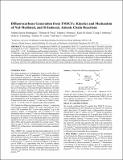Files in this item
Difluorocarbene generation from TMSCF3 : kinetics and mechanism of NaI-mediated and Si-induced anionic chain reactions
Item metadata
| dc.contributor.author | García-Domínguez, Andrés | |
| dc.contributor.author | West, Thomas H. | |
| dc.contributor.author | Primozic, Johann J. | |
| dc.contributor.author | Grant, Katie M. | |
| dc.contributor.author | Johnston, Craig P. | |
| dc.contributor.author | Cumming, Grant G. | |
| dc.contributor.author | Leach, Andrew G. | |
| dc.contributor.author | Lloyd-Jones, Guy C. | |
| dc.date.accessioned | 2021-07-26T23:35:55Z | |
| dc.date.available | 2021-07-26T23:35:55Z | |
| dc.date.issued | 2020-08-26 | |
| dc.identifier | 270005946 | |
| dc.identifier | 76e9a5d9-cc30-4c14-8ea5-04b154d9b473 | |
| dc.identifier | 85090076194 | |
| dc.identifier.citation | García-Domínguez , A , West , T H , Primozic , J J , Grant , K M , Johnston , C P , Cumming , G G , Leach , A G & Lloyd-Jones , G C 2020 , ' Difluorocarbene generation from TMSCF 3 : kinetics and mechanism of NaI-mediated and Si-induced anionic chain reactions ' , Journal of the American Chemical Society , vol. 142 , no. 34 , pp. 14649-14663 . https://doi.org/10.1021/jacs.0c06751 | en |
| dc.identifier.issn | 0002-7863 | |
| dc.identifier.other | crossref: 10.1021/jacs.0c06751 | |
| dc.identifier.other | ORCID: /0000-0003-2459-1872/work/80257929 | |
| dc.identifier.uri | https://hdl.handle.net/10023/23645 | |
| dc.description.abstract | The mechanism of CF2 transfer from TMSCF3 ( 1 ), mediated by TBAT (2–12 mol %) or by NaI (5–20 mol %), has been investigated by in situ/stopped-flow 19F NMR spectroscopic analysis of the kinetics of alkene difluorocyclopropanation and competing TFE/c-C3F6/homologous perfluoroanion generation, 13C/2H KIEs, LFERs, CF2 transfer efficiency and selectivity, the effect of inhibitors, and density functional theory (DFT) calculations. The reactions evolve with profoundly different kinetics, undergoing autoinhibition (TBAT) or quasi-stochastic autoacceleration (NaI) and cogenerating perfluoroalkene side products. An overarching mechanism involving direct and indirect fluoride transfer from a CF3 anionoid to TMSCF3 ( 1 ) has been elucidated. It allows rationalization of why the NaI-mediated process is more effective for less-reactive alkenes and alkynes, why a large excess of TMSCF3 ( 1 ) is required in all cases, and why slow-addition protocols can be of benefit. Issues relating to exothermicity, toxicity, and scale-up are also noted. | |
| dc.format.extent | 2122999 | |
| dc.language.iso | eng | |
| dc.relation.ispartof | Journal of the American Chemical Society | en |
| dc.subject | QD Chemistry | en |
| dc.subject | DAS | en |
| dc.subject | BDC | en |
| dc.subject | R2C | en |
| dc.subject.lcc | QD | en |
| dc.title | Difluorocarbene generation from TMSCF3 : kinetics and mechanism of NaI-mediated and Si-induced anionic chain reactions | en |
| dc.type | Journal article | en |
| dc.contributor.institution | University of St Andrews. School of Chemistry | en |
| dc.identifier.doi | https://doi.org/10.1021/jacs.0c06751 | |
| dc.description.status | Peer reviewed | en |
| dc.date.embargoedUntil | 2021-07-27 |
This item appears in the following Collection(s)
Items in the St Andrews Research Repository are protected by copyright, with all rights reserved, unless otherwise indicated.

